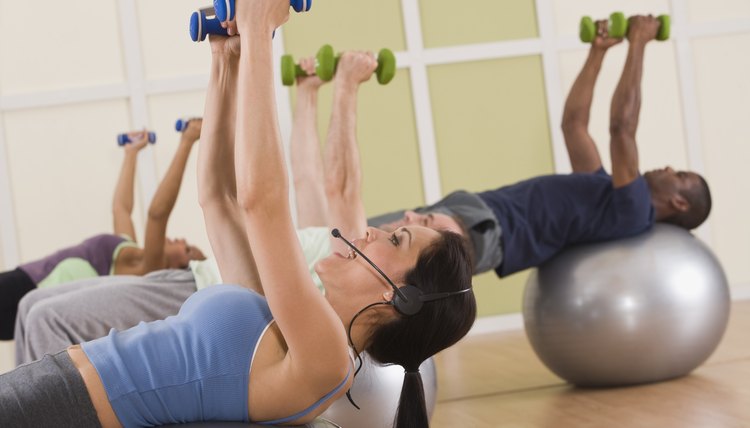Ideas for Group Strength Training Exercises

The way you structure a group-training class can make or break its success. Make it too easy and participants grow bored. Make it too challenging, and people get frustrated with you to come back. Use any combination of equipment such as medicine balls, dumbbells, barbells, stability balls, resistance bands and step benches to provide variety, offer options and to keep participants engaged.
Keep Some of the Classics
While you might want to offer cutting-edge exercises that wow your students with new challenges, start with traditional moves. Squats, lunges, rows and chest presses are classics for a reason -- they are effective and relatively easy to master. By starting with these basics, you can assess your participants' form and fitness capabilities to help you determine if they are ready for more advanced movement patterns. Add some interest to the classics by playing with the speed of movement. For example, have students emphasize the eccentric phase of the contraction by slowing down on the lengthening phase of a movement, such as when you lower the weights during a bicep curl or rise up from a squat. You can also spice up classic exercises by using non-traditional equipment. Have participants lie on a stability ball for chest presses or lunge while holding a medicine ball.
Combination Moves
Base a whole class on basic strength-training exercises, or do a series of moves that combine several exercises for greater challenge. Always introduce the movements independently at first, and give participants the option of sticking to just one if the combination is too challenging. Combination moves that work well for multiple levels include forward lunges with lateral raises, abdominal roll ups to shoulder presses, side lunges with front arm raises and squats with bicep curls.
Bring Out the Toys
Equipment such as medicine balls and resistance tubing enable you to include multi-planar, functional strength-training moves in a class. Hold a medicine ball, lunge forward and rotate toward the front knee for a lower body and abdominal challenge. Medicine balls may also be used for wood chops, Russian twists and pushup variations. Use the resistance tubing to simulate lat pull downs as you do plie squats. Stand on the tubing and pull the handles in an X across your hips as you side-step to work the abductors. Always consider the fitness and skill level of your class when introducing new equipment and movement patterns -- if you can't offer modifications, then it's best to leave that exercise out of your class plan.
Warm Up and Cool Down
The warmup can be one of the most difficult parts of the class to teach. Offering too much choreography results in confused, and potentially discouraged, participants, but you want to prepare people's cardiovascular and muscular systems for the work ahead. Once you've planned the exercises you'll do during the class, design your warmup to introduce the movement patterns to the students. After three to five minutes of light cardio movement such as marching in place, knee hugs and light jogging, have your students perform unweighted squats, lunges, arm circles and even combination movements such as squats with presses with little or no weight -- if you'll be including them in your routine. A cooldown is often overlooked as an important part of a class, but it provides closure and is an opportunity to have people stretch -- something they may neglect in their independent workouts. Leave at least three to five minutes to bring closure to class.
References
Writer Bio
Andrea Boldt has been in the fitness industry for more than 20 years. A personal trainer, run coach, group fitness instructor and master yoga teacher, she also holds certifications in holistic and fitness nutrition.
